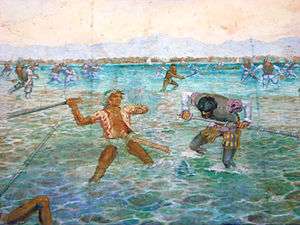Magellan Shrine
The Magellan Shrine is a large memorial tower erected in 1866 in honor of the Portuguese explorer Ferdinand Magellan on the Mactan Island of Cebu, the Philippines. The spot is believed to be the site where Magellan was killed in the 1521 Battle of Mactan.[1][2]
History

The Portuguese navigator Ferdinand Magellan was commanding a Spanish fleet when he first came to the southern Philippines to the small island of Limasawa on 7 April 1521. He was the first European to set foot in the Philippines. Due to inadequate food supplies, he was forced to land at Cebu.[1][3] Landing in Cebu with a show of heavy arms, he refused to pay any fee for entering the port. He even threatened Raja Humabon, the local ruler, and boasted about his victories in Malaca and Calicut. He then offered them gifts and befriended them. The Rajah, who welcomed Magellan to the island, wanted to hold a casi casi, a blood-brother ceremony.[3]:177 Magellan then started converting the native people to Christianity. He converted 800 people of the barangay (villages). Before conversion, the natives worshipped their own main god whom they addressed as Bathala, along with other subordinate gods. The natives who lived in small barangays were controlled by local chieftains called Rajas. During the baptisms, Magellan planted a cross at the site. The natives accepted the Catholic belief that "there is only one God".[1] Magellan was able to convert most of the powerful leaders of the islands, except one leader called Lapu-Lapu.[4][5]
During his stay in Cebu, Magellan found out that some of the local inhabitants had refused to acknowledge the suzerainty of the King of Spain, and as a warning to the villagers, he burnt a few villages. However, in spite of this warning, Lapu-Lapu opposed the control of Spain over the islands.[2] Magellan launched a naval war against Lapu-Lapu with an armada of three boats carrying Spanish soldiers and 20 boats carrying Cebuanos. In this battle, which took place on 27 April 1521, Lapu-Lapu fought valiantly with his men, armed with wooden shields, bows and arrows, and lances. Magellan and his army of Spanish soldiers and Cebuanos could not withstand the attack and were forced to retreat to their boats. Magellan was fatally wounded in the battle.[2] He was hit on the leg by a poisoned arrow and also attacked with spears and other weapons. A spear had struck his head.[5][4] Magellan's body was demanded by the Spaniards, but Lapu-Lapu refused them this favour.
A stone platform here has a plaque with the date 27 April 1521, the date Magellan was killed in the battle. Adjoining the shrine is a statue of Lapu-Lapu, who is hailed as first Filipino hero.[4]
Festival
A festival called the Kadaugan sa Mactan (Victory at Mactan), commemorating the triumph of the heroic native chieftain Lapu-Lapu over Magellan, is held on 27 April every year. On this occasion, colorful events include a ceremonial procession of "decorated bancas" (canoes) representing Magellan's three boats on the sea coast of the beach of Barangay, erecting the cross of Magellan on the island, conversion of the local people to Christianity by baptism, and scenes of the recreation of the battle.[2]
See also
- Lapu Lapu shrine
References
- Fazzi 2005, p. 32.
- "Arts and Culture". Government of Philippines. Retrieved 17 November 2015.
- Instructors Confidential Manual Supplemental Handbook. Dorrance Publishing. p. 175. ISBN 978-1-4349-4062-9.
- Grosberg & Bloom 2015.
- Ramos 2010, p. 20.
Bibliography
| Wikimedia Commons has media related to Magellan shrine. |
- Fazzi, Cindy (2005). How to Draw the Philippines's Sights and Symbols. The Rosen Publishing Group. ISBN 978-1-4042-2742-2.CS1 maint: ref=harv (link)
- Grosberg, Michael; Bloom, Greg; Holden, Trent; Kaminski, Anna; Stiles, Paul (1 April 2015). Lonely Planet Philippines. Lonely Planet Publications. ISBN 978-1-74360-537-0.CS1 maint: ref=harv (link)
- Ramos, Heidy (24 May 2010). Island of Dreams: Memoirs of My Life. Xlibris Corporation. ISBN 978-1-4628-4036-6.CS1 maint: ref=harv (link)